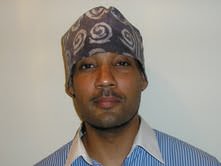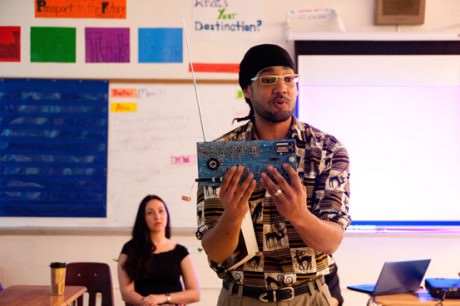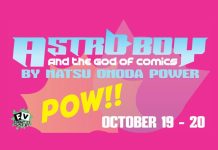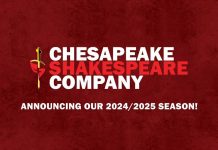Art can cross barriers of culture and race and build bridges of understanding. Fanon Hill and his partner Sam Holmes created the Black Male Identity Project – that utilizes the arts, such as painting drawing and writing, to connect with the community and change damaging stereotypes of black males in our society. The project has completed its one year run and here, Mr. Hill speaks of its impact.
Teresa: Let’s begin with the inception of Black Male Identity Project. What sparked the project and how long has it been in motion?

Fanon: The Black Male Identity (BMI) project was funded in large part by the Open Society Foundation’s Campaign for Black Achievement (CBMA). The project, administered by the community arts organization Art on Purpose, addressed issues of “Black Male Identity” through art, visual culture, and community programs. Phase one of the project launched over a year ago and officially ended January 29, 2012. Conversation pertaining to Phase two of the project is underway.
Where and how often were workshops offered?
Workshops were offered throughout the year at various locations throughout Baltimore, Maryland. Over 200 participants created art during our summer art workshops held at various community locations while over 1000 Baltimore City Public School and Independent School students engaged in BMI art making!
How did your group inform the community about the project, and its benefits and how are you helping to change the minds of the public at large?
The Black Male Identity Project worked very hard to provide accessible entry points for community members from EVERY background to “join the conversation.” We reached over 1,000 people during our citywide information session presentations at strategically chosen locations such as churches, art galleries, schools, community centers and even bus stops!
In 1925 scholar Alain Locke wrote, “Democracy itself is obstructed and stagnated to the extent that any of its channel are closed.” Through art, BMI provided an opportunity for black males, and those who love and support us, to develop images, narratives, and video offering a diverse vision of positive black male identity functioning as a resource for others.
What kind of support has BMI been getting? Did you meet with any barriers in implementing your ideas?
Novelist James Baldwin once wrote that, “The purpose of art is to disturb the peace.” Throughout the project, we protected the vision of artists even when it meant giving up our own goals. A major outcome of the project was the development of arts programming that bridged artists, community members and organizations to advance social change.
Early on in the project, some artists and community members weren’t sure if a black male identity project was needed. We welcomed their perspectives, shared our ideas and crossed boundaries that separated us. Many of those artists and community members became our strongest partners.
How did performing arts play a role in the program?
Performing arts were a major component of the project. Choreographers, musicians, spoken word artists, actors, Hip-Hop artists, and more offered their artistry in the project. Over 1000 people attended our Summer Performance Series featuring youth and local performing artists.
The main objective for BMI is to change minds – the minds of the community and of the youths themselves, about preconceived and enduring stereotypes. It also seems that exposure to artistic experiences could be potentially life changing. Have you uncovered and inspired some talent in the groups you worked with?
Today, artists who were involved in the project are connecting with children and youth in school based and after-school art programs. BMI nurtured connectivity between and among Baltimore community assets including between artists and educators, cultural, social organizations and more. I am thrilled to share that art produced by youth involved in the project will decorate the pages of The College Board’s National Office for School Counselor Advocacy Journal on Transforming the Educational Experience of Young Men of Color.

Are the art and literary projects on display?
Art from the project has been displayed at The Eubie Blake National Jazz Institute and Cultural Center, Morgan State University, New Beginning Barbershop, The Reginald F. Lewis Museum, Galerie Myrtis and many other locations. A free BMI DVD: “More Than 28 Days,”which includes the documentary of the black male identity project, images of the artwork made during the project and clips from the project’s discussions was distributed throughout Baltimore and the U.S. Please visit The Black Male Identity Project’s Facebook page for information about upcoming exhibitions.
Are resources, such as audition information and career information offered to the youth who were involved in your program?
Yes! Youth are provided with opportunities to jump into the arts vis a vis BMI partner organizations such as The Greater Baltimore Cultural Alliance, Walks of Art and others. BMI also continues to promote art-based events through social media. Youth project participants from The Urban Leadership Institute’s PRAISE Academy will soon be traveling to Baltimore’s Everyman Theatre to see The Brothers Size, a play produced by young African-American playwright Tarell Alvin McCraney
Will BMI be expanding to more cities and how can individuals show support?
Support has been amazing! Educators, advocates, activists and other community members have reached out to us from throughout the nation and beyond expressing interest in replicating the project.
Contact: [email protected].
LINK
Baltimore Renaissance Project by Brooke Hall, Justin Allen, & Theresa Keil on What Weekly.






i just attended the youth festival in hopkins plaza it was outstanding–please try to do more of these events–i will be making a donation of supplies and money in september for your fall season the singers and musical acts were great thank you from a single parent my son just loved it